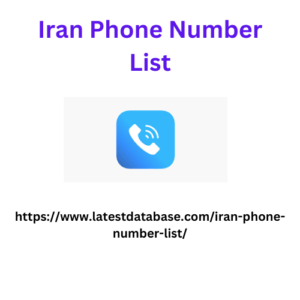In the fast-paced world of business communication, email has become the primary medium for exchanging information, ideas, and requests. Within this context, the ubiquitous “follow up” has become a staple in email vernacular, serving as a way to remind recipients of outstanding tasks or to elicit a response. However, as email communication evolves, it’s important to consider alternative approaches that can breathe new life into your messages and enhance their effectiveness.
Revisiting the “Follow Up” Paradigm
The Limitations of the Traditional “Follow Up”
While the “follow up” has long been a reliable Iran Phone Number List tool in the email writer’s arsenal, it can sometimes come across as impersonal or even slightly demanding. In a world where inboxes are constantly inundated with messages, a generic “follow up” can easily blend in with the noise, potentially diminishing the impact of your communication.
Exploring Alternative Terminology and Approaches
To stand out and engage your recipients more effectively, it’s time to explore alternative terms and approaches that can breathe new life into your Afghanistan Phone Number List email communication. By leveraging a more varied and nuanced vocabulary, you can convey your message with greater clarity, empathy, and a stronger call to action.
Alternatives to the “Follow Up”
Gentle Reminders
Instead of simply “following up,” consider framing your message as a gentle reminder. This approach conveys a sense of understanding and acknowledges the recipient’s busy schedule, while still prompting them to take the desired action. Examples of gentle reminder language include:
- “Gently reminding you about…”
- “Just a friendly reminder regarding…”
- “Checking in to see if you had a chance to…”
Expressions of Appreciation
Incorporating expressions of appreciation into your email can make the recipient feel valued and more inclined to respond. By acknowledging their time and efforts, you can create a more positive and collaborative tone. Consider phrases like:
- “I appreciate you taking the time to…”
- “Thank you for your attention to this matter.”
- “I’m grateful for your continued support on this project.”
Collaborative Language
Framing your email as a collaborative effort can foster a sense of partnership and shared responsibility. This can be particularly effective when working with teams or cross-functional stakeholders. Examples of collaborative language include:
- “Let’s discuss the next steps on this project.”
- “I’m looking forward to working with you to…”
- “Together, we can ensure this task is completed by…”
Actionable Requests
Instead of a generic “follow up,” consider making a specific, actionable request that clearly communicates your needs and expectations. This approach can help the recipient understand the importance of your message and the specific actions required. Examples include:
- “Could you please provide the updated report by Friday?”
- “I’d appreciate if you could confirm your availability for the meeting next week.”
- “Would you mind sharing your feedback on the proposal by the end of the day?”
Enhancing Email Effectiveness through Varied Terminology
By expanding your email vocabulary and exploring alternative approaches to the traditional “follow up,” you can craft more engaging, personalized, and effective communications. This not only helps your messages stand out in a crowded inbox but also fosters stronger relationships and collaboration with your recipients.
Remember, the key to successful email communication is to tailor your language to the specific context, audience, and desired outcome. By incorporating a diverse range of terms and techniques, you can elevate your email game and achieve your communication objectives with greater ease and impact.


